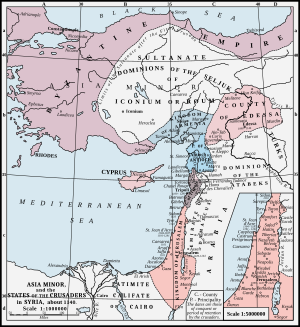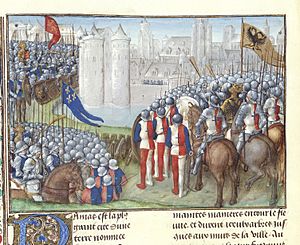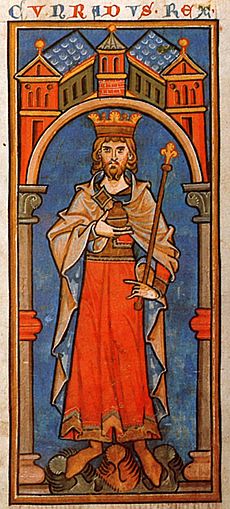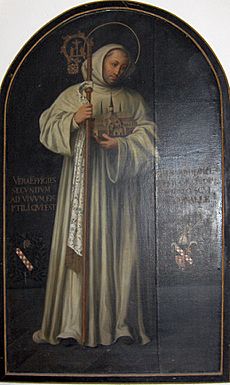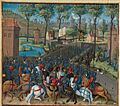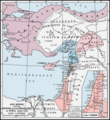Siege of Damascus (1148) facts for kids
Quick facts for kids Siege of Damascus |
|||||||
|---|---|---|---|---|---|---|---|
| Part of the Second Crusade | |||||||
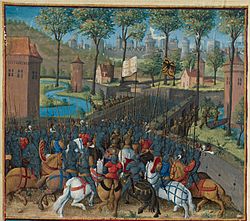 Siege of Damascus, miniature by Jean Colombe from Sébastien Mamerot's book "Passages d'outremer" (1474) |
|||||||
|
|||||||
| Belligerents | |||||||
|
Muslim forces:
Supported by:
|
|||||||
| Commanders and leaders | |||||||
| Baldwin III of Jerusalem Everard des Barres Raymond du Puy Conrad III of Germany Frederick of Swabia Louis VII of France |
Mu'in ad-Din Unur Supported by: Saif ad-Din Ghazi INur ad-Din Zangi |
||||||
| Strength | |||||||
| 50,000 troops | Unknown | ||||||
| Casualties and losses | |||||||
| Heavy | Unknown | ||||||
The Siege of Damascus was a major battle that happened between July 24 and July 28, 1148. It was a key event during the Second Crusade. The battle ended with the Crusaders losing, which caused the entire crusade to fall apart.
Two large Christian armies, led by Louis VII of France and Conrad III of Germany, marched to the Holy Land. They were responding to a call from Pope Eugene III for a new crusade. Both armies faced huge problems crossing Anatolia (modern-day Turkey). Most of their soldiers died or were lost.
The main goal of the Second Crusade was to recapture Edessa (a city that had fallen to Muslim forces). However, in Jerusalem, King Baldwin III and the Knights Templar wanted to attack Damascus instead. At a big meeting called the Council of Acre, leaders from France, Germany, and the Kingdom of Jerusalem decided to change their target to Damascus.
The Crusaders chose to attack Damascus from the west. This area had many orchards, which would give them food. When they reached the city walls, they immediately started the siege, using wood from the orchards. But on July 27, the Crusaders moved to the eastern side of the city. This area was less protected but had very little food or water. Soon after, the local Crusader leaders refused to continue the siege. The three kings had no choice but to give up. The entire Crusader army went back to Jerusalem by July 28.
Contents
Why the Siege Happened
Before this siege, there had been other fights between the Crusaders and the rulers of Damascus. In 1129, the Crusaders tried to attack Damascus but failed. Later, in 1140, the ruler of Damascus, Mu'in ad-Din Unur, even made a deal with the Crusaders. He needed their help against a powerful enemy named Imad ad-Din Zengi.
In 1147, King Baldwin III of Jerusalem tried to capture a city called Bosra, south of Damascus. He was invited by a local leader who was fighting with Unur. But when Baldwin arrived, the city was already guarded by soldiers from Damascus. Baldwin decided to leave rather than risk a siege.
The Second Crusade Begins
The Second Crusade began after the city of Edessa fell in 1144. This loss shocked Christians in Europe. Pope Eugene III and Bernard of Clairvaux called for a new crusade. Two large armies, led by Louis VII of France and Conrad III of Germany, marched across Europe. They arrived in Constantinople in late 1147.
Both armies had terrible journeys through Anatolia. Most of their soldiers died. Louis left his troops and sailed to Antioch. He then went to Jerusalem to complete his vow as a Crusader. Conrad, who was sick, also arrived in Jerusalem a few weeks later in April 1148. The original plan was to retake Edessa. But in Jerusalem, King Baldwin III and the Knights Templar wanted to attack Damascus instead.
The Council of Acre Meeting
A very important meeting called the Council of Acre took place on June 24. Many powerful leaders from Europe and the Holy Land attended. These included King Conrad, King Louis, King Baldwin, and important knights like the Knights Templar and Knights Hospitaller.
At this meeting, Louis and Conrad were convinced to attack Damascus. Some local leaders in Jerusalem thought this was a bad idea. They pointed out that the rulers of Damascus, though Muslim, were often allies against the powerful Zengid dynasty. The Zengids were a bigger threat.
However, Conrad, Louis, and Baldwin insisted. They saw Damascus as a holy city for Christians. They believed capturing it would be a great victory. In July, their armies gathered and marched towards Damascus. They had about 50,000 soldiers in total.
Many historians now believe that attacking Damascus was almost unavoidable. King Baldwin III had already tried to capture the city before. This had hurt the relationship between Damascus and the Kingdom of Jerusalem.
The Disaster at Damascus
The Crusaders decided to attack Damascus from the west. This area had many orchards, which would provide them with food. They arrived near the city on July 23. The army from Jerusalem led the way, followed by Louis's and then Conrad's forces. The thick orchards and gardens made it very hard for the Crusaders to move.
July 24: The First Attack
On Saturday, July 24, the Crusaders began their attack. They moved along the Barada river. The Muslim defenders were ready. They constantly attacked the Crusader army as it moved through the orchards. These orchards had towers and walls, and the Crusaders were hit with arrows and spears on the narrow paths. There was fierce fighting in the orchards near Mezzeh.
Thanks to a charge led by King Conrad, the Crusaders fought their way through. They pushed the defenders back into Damascus. The Crusaders then set up their siege positions outside the city walls. They used wood from the orchards to build their siege equipment.
Inside Damascus, people built barricades in the streets, expecting an attack. The ruler, Unur, had asked for help from Saif ad-Din Ghazi I of Mosul and Nur ad-Din Zangi of Aleppo. Unur also led an attack on the Crusader camp. The Crusaders were pushed back into the orchards, where they faced ambushes.
July 25: Fierce Fighting
On Sunday, July 25, the Damascus forces launched a counter-attack. They suffered heavy losses, including a 71-year-old lawyer and a well-known scholar. By the end of the day, the Crusaders set up a camp on the Green Field, an open area used for training by the Damascene cavalry.
July 26: Defenders Get Help
The defenders attacked to the north of Damascus to push back the Crusaders. Despite heavy fighting, they cleared the area. This allowed them to receive more soldiers from Lebanon and from Saif ad-Din starting on July 26. These reinforcements included archers, which greatly increased the number of defenders and their weapons.
July 27: A Bad Move
The Crusaders probably planned to focus on the eastern and southern parts of the city. They wanted to attack the weakest gate, Bab al-Saghir, which was made only of mud bricks. However, on July 27, the Crusaders decided to move to the plain on the eastern side of the city. This area was less fortified but had much less food and water.
There were arguments on both sides. Unur, the ruler of Damascus, worried that if he accepted help from Saif ad-Din or Nur ad-Din, they might try to take over his city. Among the Crusaders, there was a big disagreement about who would rule Damascus if they captured it. The local leaders from Jerusalem wanted Guy I Brisebarre to rule. But Thierry of Alsace, the Count of Flanders, wanted it for himself. King Baldwin, Louis, and Conrad supported Thierry.
This disagreement greatly hurt the siege. The local leaders preferred that Damascus stay Muslim rather than be given to Thierry. Some stories even say that Unur bribed the Crusader leaders to move to the worse position. He also promised to break his alliance with Nur ad-Din if the Crusaders left.
July 28: The Retreat
Nur ad-Din and Saif ad-Din had now arrived nearby. They were talking with Unur about taking control of Damascus. This was something neither Unur nor the Crusaders wanted. Saif ad-Din also seemed to tell the Crusaders to go home. With Nur ad-Din's army so close, the Crusaders could not return to their better position.
The local Crusader lords refused to continue the siege. The three kings had no choice but to give up. First Conrad, then the rest of the army, decided to retreat back to Jerusalem on July 28. Muslim archers followed them, constantly attacking during their retreat. Some historians wrote that the Templars accepted a bribe to abandon the siege.
What Happened Next
After the defeat, each Christian group felt betrayed by the others. A new plan to attack another city was made, but it was quickly abandoned. The lack of trust from the failed siege was too great. This distrust lasted for many years and harmed the Christian kingdoms in the Holy Land.
After the battle, Conrad went back to Constantinople to strengthen his alliance with Manuel I Komnenos. Because of the attack, Damascus no longer trusted the Crusaders. The city was officially given to Nur ad-Din in 1154. Bernard of Clairvaux, who had called for the crusade, was also embarrassed by its failure. He tried to distance himself from the disaster.
Lasting Impact
A French Crusader named Robert de Brie, who was at the Siege of Damascus in 1148, is sometimes given credit for bringing the Damask rose from Syria to Europe. The Crusaders also carved their symbol, the fleur-de-lis, on a stone outside one of Damascus's gates.
Later, in the 1920s, during the time of the Mandate for Syria and the Lebanon, the French built the Mezzeh prison. This prison was built on a hilltop that had structures dating back to the Crusader period. It was used to hold people who fought against French rule.
Images for kids


